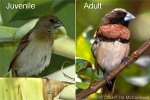Cook Islands Biodiversity Database
Species Page
Lonchura castaneothorax
Toa Kere-a-Rangi* (MG)Chestnut-breasted Mannikin
Multimedia & Additional Resources
| Type | Description | Download |
| Adult and Juvenile (French Polynesia) | 34KB | |
| Adult and Juvenile (Mangaia) | 32KB |
General Information
Cook Islands Distribution
| Southern Group: Present Makatea: | ||||||||
RR |
MG |
AT |
MK |
MT |
AK |
PL |
TK |
MN |
++ |
++ |
|||||||
| Northern Group: | |||||
TN |
MH |
RK |
PK |
NS |
SW |
Scientific Taxonomy
Lonchura castaneothorax Gould, 1837
SYNONYMS: Lonchura castaneothorax castaneothorax [the only Australian subspecies, there are 4 others in PNG]
TAXONOMY: ANIMALIA; CHORDATA; GNATHOSTOMATA (Jawed Vertebrates); TETRAPODA; AVES; NEORNITHES; Passeriformes; ESTRILDIDAE
More Information
IDENTIFICATION: Small thick-set bird to 11cmTL, 28cmWS. ADULTS similar; beak silver blue; brown with grey head and black face and throat; breast chestnut, with black band and white belly; rump and tail orange, undertail black. MALES sing and do the courtship dance - definitive. Females paler and duller; black face with more brown flecking; chest-bar thinner; beak narrower and less silver. JUVENILE olive-brown above, pale below without black face or chest-bar. Seen in flocks feeding on grass seeds. 4-8 eggs, mainly incubated by female, and both sit on nest at night. Hatch in 14 days and fledge after 21 days, and weaned in 21 days.
Vouchers & References
Vouchers:
Rarotonga: two fieldspecimens, 2006/10, Charleen Nelio Heather, behind Lagoon Lodges, Aroa, with ID as Chestnut-breasted Mannikin; 11 specimens 2001 imported by Anna Nelio assisted by daughter Charleen Nelio, with NZDoC ID as Lonchura spp., were later given to Ata Herman. Mangaia: ~4 adults and ~4 juveniles fieldspecimens+photo, 2006/5, Vaitate swamp, G.McCormack, ID G.McCormack and I.Karika as Lonchura castaneothorax, G.McCormack (CINews 13/5/2006) had suggested this identification based on a description by Peter Ngatokorua who also reported that a road gang had first seen the birds in 1999 near Tavaenga swamp.
References:
None recorded.
Data Update History (information):
zTX, zB06a, zM06a, zD06a
Web Resources
Citation Information
McCormack, Gerald (2007) Cook Islands Biodiversity Database, Version 2007.2. Cook Islands Natural Heritage Trust, Rarotonga. Online at http://cookislands.bishopmuseum.org. ![]()
Please refer to our use policy.

